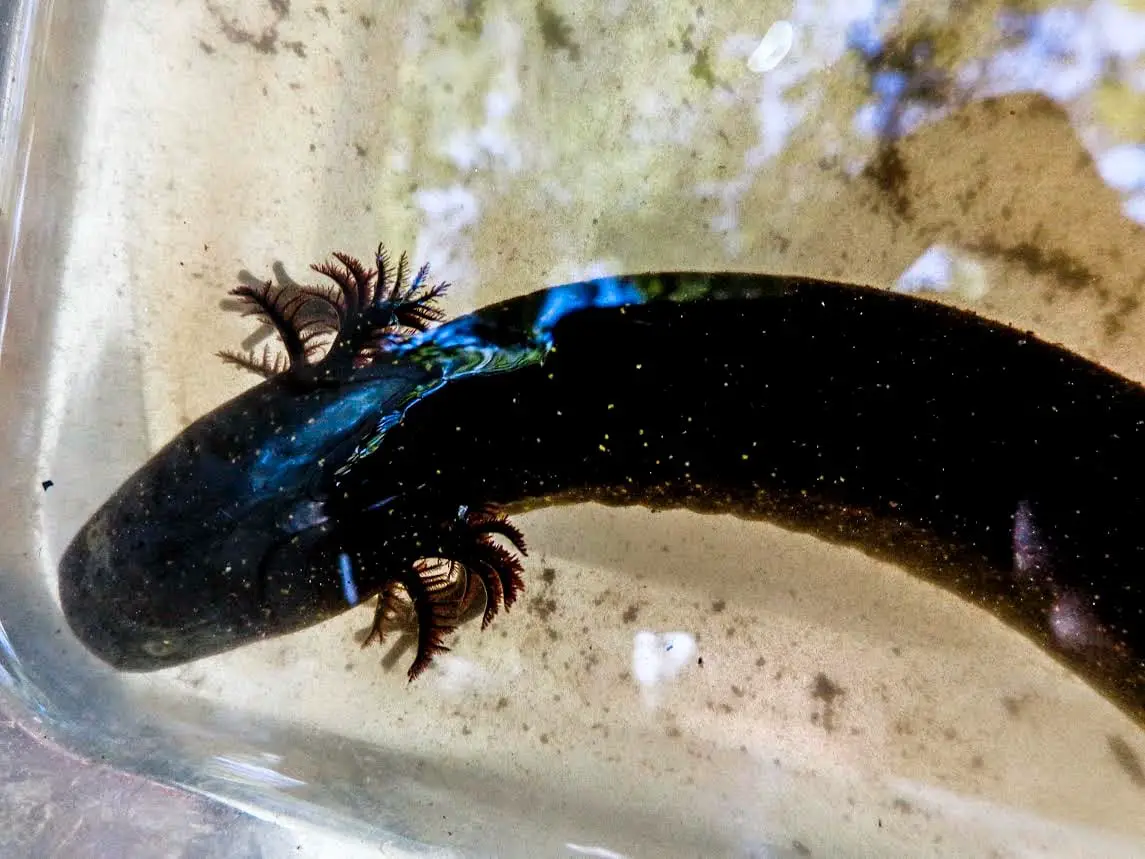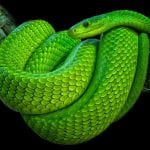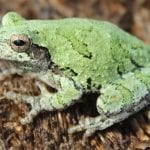Scientific Facts
| Common Name | Greater Siren |
| Scientific Name | Siren lacertina |
| Captive Lifespan | More than 20 Years |
| Size | 7 – 38 inches (18 – 97cm) |
| Mass | 1.9 – 35.3oz. (55 – 1000grams) |
| Habitat | Swamps, lakes, rivers, streams |
| Country of Origin | Southeastern United States |
Physical Description
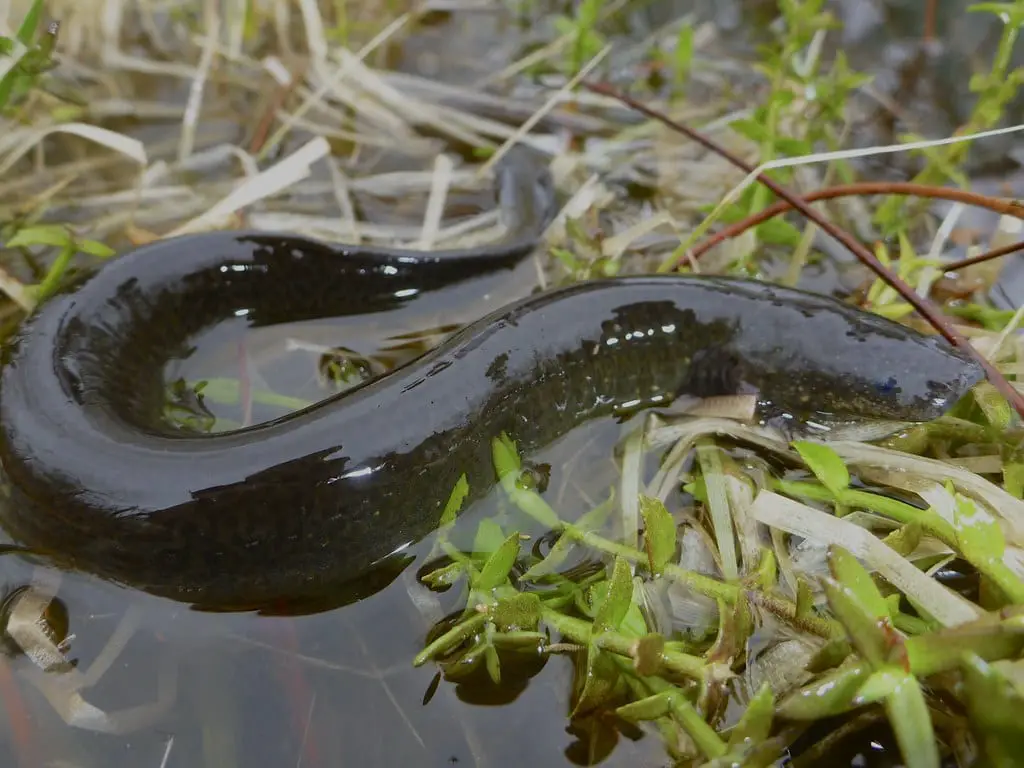
The body of Siren lacertina is long and eel-like. The body coloration ranges from grey through olive to almost black.
Greater sirens are among the longest salamanders in the world, capable of reaching the impressive 38.5 inches in length. There are only three other types of salamanders that are known to exceed the size of Greater sirens, namely the Chinese and Japanese greater salamanders, as well as the two-toed amphiuma.
Despite lacking rear legs, Siren lacertina possesses forelegs that are rather tiny in size. The tail of Greater sirens is equipped with a fin. Being laterally compressed, the tail allows these amazing creatures to be agile, excellent swimmers.
Greater sirens are termed “neotenic” creatures since they do not transform into land-dwelling as they mature and become adults. Instead, they retain an aquatic lifestyle, thanks to certain larval characteristics that remain intact as these animals reach adulthood, such as external gills.
Types
Siren lacertina (Greater siren) is an amphibian that belongs to the Siren genus, along with two other members, namely Siren intermedia (Lesser siren), and Siren reticulata (Leopard eel or Reticulated siren).
Greater sirens are the largest in the genus, as well as the largest amphibians that are known to occupy North America.
Habitat & Lifespan
Greater Sirens inhabit the Coastal Plains of the United States of America, from Washington in the south to the southern parts of Alabama and all the way across Florida. Although isolated, there are populations of Greater sirens that are known to occupy Tamaulipas, Mexico, and southern Texas.
Greater sirens’ preferred habitat includes weed-choked, muddy swamps, ditches, and ponds. These creatures are also known to inhabit the vegetated shores of large streams and lakes alike.
Despite being completely aquatic, Greater sirens are fully capable of crossing land whenever the circumstances require such action to be undertaken.
Living in wetlands, Siren lacertina prefers water bodies where there is no or only very slow existing current, as well as a thick, dense, sufficient layer of organic material suitable for burrowing purposes.
Thanks to their ability to aestivate, Greater sirens can inhabit both permanent and seasonal wetlands, since if their wetland is to dry up, these amphibians are to burrow into the mud.
The lifespan of Siren lacertina in the wild remains unknown up-to-date. In captivity, Greater sirens are known to live up for more than 20 years, with the longest recorded lifespan of a captive Greater siren being 25 years.
Behavior
Greater sirens are carnivorous amphibians; however, they have been reported to also eat vegetation. Spending the day in dense, thick vegetation, Greater sirens become active during the night, when they get to hunt and prey on various insects, among other favorite treats.
Similar to the call of the American green tree frog, Greater sirens’ calls sound like yelps or clicks, giving these amphibians the reputation of being quite vocal.
If necessary, these extraordinary creatures can aestivate for multiple years. Aestivation is somewhat similar to hibernation, although aestivation only occurs because of a hot or dry period, and not because of a cold period. If these creatures are to aestivate, they burrow themselves into the mud, exuding a unique cocoon made up of dead skin cells.
Little is known about the courtship behavior of Greater sirens, except for the fact that mating occurs throughout February and March. Females have been observed to guard their egg clutches for about two months.
Housing
Keeping in mind that greater sirens become quite large, and they are also fairly active when provided with a suitably-sized enclosure, keepers want to utilize a 100-gallon aquarium for housing a single adult greater siren.
For housing, a greater siren that has not yet reached its full size (less than 30 inches in length), a 70-gallon tank equipped with 55-gallon filters will work like a charm.
Make sure that the tank has a secure top because greater sirens will almost inevitably try to leave their enclosure late at night when they become active. They will not hesitate to try to escape if given a chance.
For securing the aquarium’s lid properly, caregivers can line the lid with foam.
The safest and smartest way to secure the screen cover is to use cage clamps.
For newly acquired greater sirens, it is strongly recommended that caregivers are to attach a pillowcase or towel right beneath the tank’s screen top. This is needed when first acquired; greater sirens are known to rub their noses on the screening while attempting to find a way to escape. Nose rubbing can cause injury, thus, compromising the amphibian’s health.
Within only a couple of weeks after being acquired, the greater siren will understand the boundaries of its enclosure, and so the pillowcase or towel can be then dis-attached.
Substrate
In the wild, greater sirens are known to burrow into the mud. Since using a muddy substrate will inevitably lead to an overly messy enclosure, keepers are strongly recommended to opt for large aquarium gravel.
Additionally, all sorts of hiding spots should be provided, suitable options being ceramic planters, sunken tubes, PVC pipes, as well as Mopani wood, among others. For extra security, plastic plants can also be added. Remember, a greater siren needs a suitable hiding spot where it can get completely out of sight whenever desired.
Apart from gravel, a softer type of substrate, such as sand, can work excellent.
Make sure to avoid any substrate with high pH since it will raise the pH of the water, leading to possible health issues in return.
Temperature & Lighting
Ensure that the water temperatures within the enclosure are kept within the 75 degrees Fahrenheit range at all times. Mind that if temperatures are to get only a bit higher or a bit lower, this should not be a big concern. However, do check out daily whether the temperatures are maintained within the desired range by using a reliable thermometer.
Ideally, water temperatures should be kept from 70 degrees Fahrenheit and up to 76 degrees Fahrenheit. Then again, this amphibian is known to tolerate a wider range of temperatures, but it is always best to stay in the golden middle of the 75 degrees Fahrenheit range.
For captive greater sirens, lighting is only optional, as it is not a crucial factor for their health and well-being. However, for being able to fully enjoy the beauty and curious habits of a captive greater siren, keepers are highly recommended to make use of a fluorescent UV tube that spans across the very top of the enclosure.
As a rule of thumb, utilizing brighter lights at night vs. dim lighting during the day is believed to encourage captive greater sirens’ activity. However, only opt for daytime dim lighting and nighttime bright lights when the greater siren has been well-adjusted to its captive lifestyle. Never utilize this lighting method for newly acquired greater sirens, and/or for greater sirens that are not feeding well.
For the purpose of observing captive greater sirens after dark, night-viewing bulbs are another suitable option.
Diet
The diet of greater sirens in the wild is made up of a fairly wide variety of prey, such as frogs, other smaller salamanders, tadpoles, fish, shrimps, insects, snails, crayfishes, and carrion.
According to some experts, greater sirens do also occasionally eat small rodents and ducklings. Also, it is believed that juvenile greater sirens feed on algae.
The majority of the diet of captive greater sirens should consist of freshwater fish, such as shiners and minnows, as well as earthworms.
One of the captive greater sirens’ top favorite treats is small crayfish. Keepers should best remove the claws to ensure the safety of the amphibian, though.
Feeding a greater siren with various insects, with crickets making up for the bulk, is also accepted very well as a part of a varied diet.
Occasionally, caregivers can also offer a pink mouse. However, relying heavily on feeding with rodents is not a good idea.
Every now and then, aquatic plants can be also provided as part of these amphibians’ diets. It is best that live aquatic plants are to be present within the enclosure so that the amphibian can choose when and whether to consume these as needed.
Unlike with other captive amphibians, there is no need to opt for additional dietary supplementation.
Eating Habits
Greater sirens have earned a solid reputation as voracious hunters. With this in mind, keepers should make sure to provide live food to these amphibians’ diet, as to cater to their natural hunting instincts, as well as for the joy of watching the greater siren’s authentic, intriguing feeding behavior.
Sleeping Habits
Greater sirens are known to become dormant during periods of drought. This dormant period is known as aestivation. While they may aestivate, depending on the conditions in their habitat, greater sirens do not hibernate.
Greater sirens’ aestivation is possible thanks to the way these creatures bury themselves into the mud. Then, they form a unique cocoon, which is rather slimy on the inside, allowing them to survive and emerge back as soon as the drought period has been brought to an end.
These amphibians are nocturnal, so during the day, they can rarely be spotted active.
Water
For keeping a healthy captive greater siren, water quality is of utmost importance. For this purpose, keepers want to make use of top-grade water filters.
Do not use distilled water when taking care of a captive greater siren. Distilled water can cause minerals and salts to leach out of the animal via a process known as osmosis.
In most cases, tap water can work great for taking proper care of a greater siren kept as a pet, unless tap water in the keeper’s area of residence is unsuitable for drinking purposes. As a rule of thumb, tap water must be de-chlorinated. This can be achieved by using instant de-chlorinating drops, such as those sold for tropical fish in most pet stores.
Apart from de-chlorinated tap water, bottled spring water can be also confidently used by the caregiver.
Development and Reproduction
The mating season for greater sirens is between February and March, when these amphibians are known to deposit up to 500 eggs, with eggs being adhered to each other, looking like small grapes, on the very bottom of densely vegetated breeding sites. Eggs are deposited singly, or only in small clusters.
It remains unclear whether fertilization is external or internal.
Based on the rather limited available evidence regarding the mating and parental behavior of greater sirens, females are believed to possibly guard the eggs.
Eggs are to hatch at some point between April and May. While too little is known about the larval period of greater sirens, they are known to measure about 0.59 inches (respectively, about 1.5cm) upon hatching.
Throughout their lifespan, greater sirens retain larval features, with their gills remaining external. These amphibians do never develop hind limbs.
Being approximately 11 mm in total length, hatchlings possess distinct stripes. These stripes fade away gradually as the sirens mature. Within the very first year of life, the stripes are completely lost.
A yellow or red, triangular-shaped marking is located on the snout of newly hatched greater sirens.
As compared to adults, juvenile greater sirens tend to be somewhat more brightly colored. They also have more of a mottled appearance.
Siren lacertina reaches sexual maturity at about two or up to three years of age.
Although these amphibians are known to breed only once a year, breeding may not occur at all, depending on environmental conditions.
Young greater sirens live in shallower water than adults do, most commonly among water hyacinths’ roots.
How to Breed
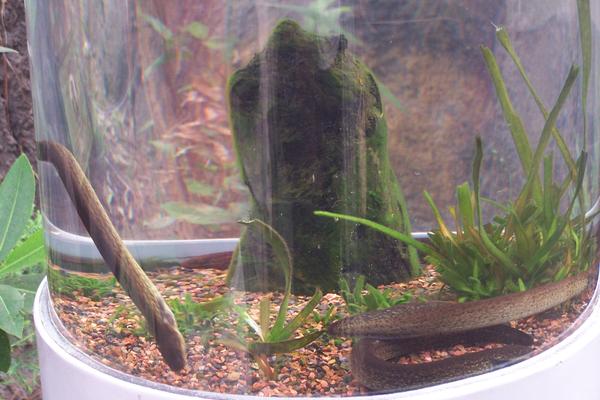
Up-to-date, too little is known about the mating habits of greater sirens in the wild, and even less is known about breeding these extraordinary creatures in captivity.
There have been only very few recorded breeding attempts, executed by highly experienced herpetoculturists. However, there is only rather limited, if publicly accessible at all, available data regarding how to breed greater sirens in captivity.
Handling
Even though greater sirens can be successfully raised in captivity, making up for stunning, incredible pets to admire and enjoy, these creatures do not tolerate handling.
Handling a greater siren must only happen when needed, and not merely for the keeper’s entertainment.
Firstly, the skin of greater sirens is very easy to damage, so nylon nets, as well as any excess handling, must be avoided. Secondly, even when well-accustomed to their captive lifestyle, becoming fairly mild-tempered creatures, greater sirens are fully capable of administrating a painful bite whenever their natural instinct for self-protection is to be triggered by undesirable handling.
When having to move greater sirens, for instance, when cleaning the enclosure, keepers should make use of a large fishnet for best results. Avoid picking a greater siren by hand.
How to Treat and Prevent Possible Health Issues
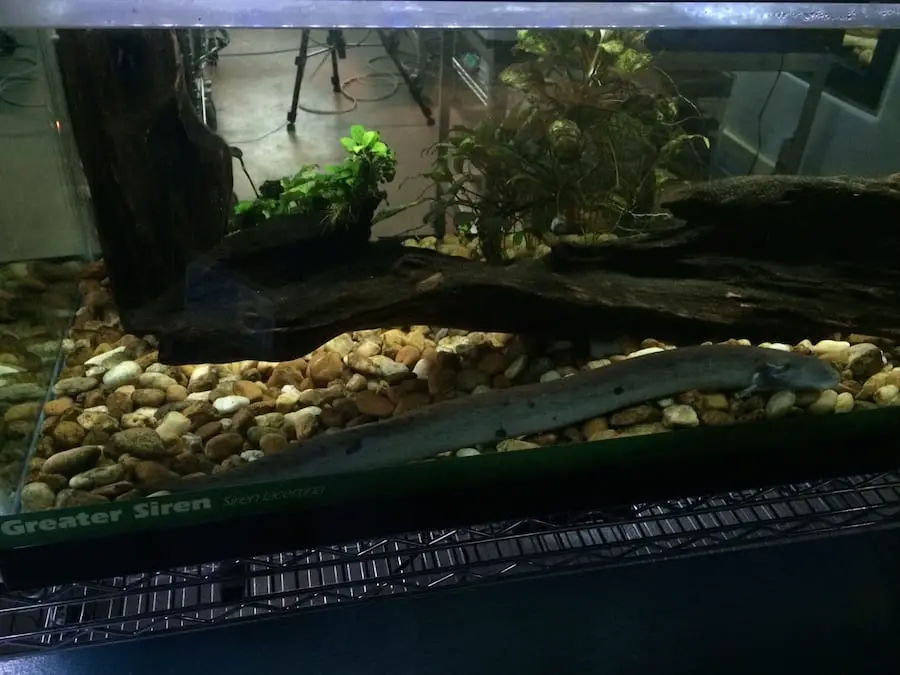
As a rule of thumb, greater sirens are very hardy amphibians. However, this should not be an excuse for not taking the utmost care of the water quality within the enclosure at all times to ensure these creatures’ health, well-being, and longevity.
Although greater sirens are hardy amphibians to keep as pets, do mind that diagnosing, as well as treating possible health issues tends to be a complicated task, so it is the caregiver’s responsibility to do his/her best to provide the right conditions for the amphibian to thrive in captivity, as to never experience any serious health issues at all.
Keepers must acknowledge that frequent water changes, as well as effective water filtration, are crucial to captive greater sirens’ health.
If caregivers are to notice red bumps on the body and/or head of their captive greater siren, this can be a sign of variable possible health issues, ranging from parasites through small injuries and bacterial infections. If the bumps are the result of the greater siren dealing with parasites, mind that parasites can be well-tolerated provided the siren is in good overall health. However, the best thing to do is to consult with a qualified herp vet as soon as possible, and especially if more bumps are to appear or if the existing ones multiply and/or appear more irritated than in the very beginning.
If the keeper is to notice that his/her greater siren has stopped eating and has developed white blotches on the body, this can be a sign of bacterial infections. In such cases, opting for Holtfreter’s salt solution or methylene blue can make a suitable treatment. Before applying any treatment, always read the instructions carefully, and for best results, consult with a qualified vet in advance.
For treating a greater siren with methylene blue solution, it is usually best to start with the only ½ of the recommended fish dose as labeled on the bottle. Next, soak for about 1 hour, since most amphibians, including greater sirens, are to absorb medications over a significantly bigger surface area than fish do. Make sure to watch out for signs of irritation, for instance, agitated swimming and/or the greater siren rubbing its skin against various objects within the enclosure.
As there are no set guidelines for treating greater sirens using methylene blue, keepers must only increase the dose gradually if needed, and to take a day off from the treatment every 3rd day, when re-evaluation and careful, detailed recording of how the treatment has been going, should take place.
If you are keeping more than a single greater siren, and one or more of the sirens is/are to exhibit possible signs of illness, separate it/them from the healthy sirens in individual tanks prior to the treatment.
To prevent possible health issues when taking care of a greater siren, do not cohabitate the amphibian with turtles. Turtles will begin to bully and stress out the siren at some point, by administrating bites. Not the least, turtles do produce a great deal of ammonia, and this is deadly to amphibians.
For keepers using large aquarium gravel as substrate, mind that greater sirens may ingest gravel when feeding on the bottom, and this can lead to impaction. Fine substrates, such as sand, as well as large river stones that cannot be swallowed, make the safest options.
Do mind that some of the protective slimes are to rub off as the animal attempts to escape, thus, leaving it open for fungal and/or bacterial infections, so check out carefully whether such issues are on the horizon and act accordingly to prevent them in advance, as much as possible.
Possible Dangers to Humans
In general, there are no adverse effects of Siren lacerta on humans.
Greater sirens are not poisonous; they do not have sharp claws or extremely powerful jaws as to lead to lethal consequences with humans. However, these creatures have sharp teeth and can administer painful bites if treated unproperly.
Also, like all reptiles and amphibians alike, greater sirens can carry Salmonella bacteria, which can be transferred to humans. To avoid Salmonella-related issues, keepers must always wash their hands thoroughly with antibacterial soap and hot water every time after getting in touch with a greater siren, as well as every time after cleaning the enclosure.
Young children below the age of 7 should not be left unattended with a greater siren in order for the keepers to limit the chances of any unwanted issues that may occur.
Availability: How to Get a Greater Siren?
Unlike other amphibians, one can choose to keep as pets, most greater sirens are not captive-bred but field collected. At this time, there is still no greater sirens captive breeding going on a steady basis.
If getting a greater siren manually from the wild, it is important to have the specimen fully examined by a qualified vet.
For those who choose to obtain a greater siren from reputable retailers, this is certainly the smartest option, since reliable retailers will be able to provide a guarantee for the amphibian’s health and well-being. Also, greater sirens that have been well-adapted to living in captivity will highly likely do better when introduced to their new homes, as compared to newly acquired sirens from the wild.
Fun Facts
When greater sirens are to become dormant by aestivating during periods of drought, when they are to burrow themselves in the mud, forming a cocoon that enables them to survive, these amazing amphibians have been reported to be capable of remaining within their cocoons for over five years before turning back to their normal lifestyle! During the aestivation period, their gills atrophy.
When examined in laboratory situations, the aestivation period leads to greater sirens losing more than 85% of their total body weight, yet still surviving! In the wild, aestivation rarely exceeds 1 and up to 3 months. The cocoons formed by greater sirens are slimy on the inside and are made up of dead skin cells.
Greater sirens, like most salamanders, tend to be often regarded as slow-moving, fairly inoffensive creatures. However, greater sirens have earned a solid reputation as “rule-breakers,” as they are fully capable of biting viciously when it comes to self-defense. Plus, captive greater sirens are known for attempting to escape from the enclosure whenever given a chance to do so. Also, greater sirens are major predators in their natural habitat in the wild.
It is believed that greater sirens can sense disturbances in electric fields.
Contrary to most salamanders, greater sirens are fairly vocal. When disturbed, they produce loud, Yelp-like, or other distinct sounds.
Greater sirens, along with Dwarf sirens and Lesser sirens, are known to possess a variety of unique characteristics that are not typical for any other salamanders. Because of this, some taxonomy experts believe that greater sirens actually belong to a different order than true salamanders do.
Despite being considered common in their geographic range, in certain regions, such as in Maryland, greater sirens are considered endangered. Due to habitats encroachment, related to urban and agricultural development, characterized by harmful pesticides runoff, the future of greater sirens populations is potentially threatened by human activity.
How to Take Care of a Greater Siren
Greater sirens are very neat animals. They are especially hardy creatures, and easy to keep in general, as long as their basic care requirements are strictly followed.
Although greater sirens thrive in mud-bottomed water bodies in the wild, mud does not work well in indoor enclosures. Any type of substrate utilized should consist of non-abrasive particles, as any abrasive surfaces can quickly lead to tiny cuts, and in return, even tiny cuts can cause infections that may be very difficult to treat.
For taking proper care of a greater siren, keepers must make sure to secure the shelter, as these animals are notorious escape artists. Watch out for nose rubbing, which may occur on the screen top with newly acquired greater sirens, as well as at any time when the amphibian is to be stressed. However, if suitable hiding spots, as well as an appropriately-sized tank, are provided, greater sirens will soon get well-used to the borders of their enclosure, and any nose rubbing would rarely occur.
For keepers who intend to use sand as a substrate, please mind that it may be ingested with food, and this can lead to impactions. Because of this, smooth gravel is a much safer option, as long as only suitably-sized rocks that the amphibian will not be able to swallow, such as river rocks available in most aquarium stores, are to be utilized.
When taking care of a greater siren and using rocks as a substrate, the captive amphibian will not be able to burrow. Thus, sections of the PVC pipe must be provided as shelter. Do mind that while PVC is considered safe, other types of plastic may not work well.
For helping a captive greater siren feel comfortable and live up to its fullest potential, aquarium safe rocks of driftwood can be used for making a cave. Make sure to silicone pieces together, or otherwise, the siren will easily move the pieces apart.
As greater sirens prefer weed-choked habitats, plastic plants can work great, as long as these are properly weighed down using fish-safe ties. Plastic plants will contribute to creating a wonderful sense of security that your greater siren fellow will surely appreciate.
The major concerns for greater sirens raised in captivity are diet and water quality. Provide a varied diet, especially rich in earthworms and whole fishes. Make sure to keep the water within the enclosure clean. Also, check ammonia levels regularly, since amphibians can die off because of being exposed to higher ammonia levels.
Although it is not the first association that crosses one’s mind at the mere glance of a greater siren, these creatures can be very sweet-natured, and not at all vicious, when properly taken care of in captivity. Once they get used to their enclosure and caregiver, captive greater sirens can allow for their sides to be gently touched, so that whenever the amphibian has to be moved during water changes, handling may be very enjoyable, as long as it is only done with moderation and caution.
Greater sirens may get bored if kept in the enclosure, all alone. Since taking care of multiple greater sirens tends to be a challenging task, keepers can consider adding fish as companions.
Since greater sirens are known to sometimes feed on vegetation, it is a great idea to supplement nightcrawlers with algae tabs.
Occasionally, when startled, captive greater sirens may end up on the floor of the enclosure. In such cases, using a clean pillowcase can work great to protect the amphibian from harm.
If taken proper care of, a captive greater siren’s gills will appear fluffy, and the amphibian will be very active.
FAQs
What Types of Animals Are Greater Sirens?
Greater sirens belong to the genus Siren, along with two other members, the lesser siren, and the reticulated siren. Greater sirens are eel-like amphibians, the largest representatives of the genus Siren.
Are Greater Sirens Endangered?
According to the International Union for Conservation of Nature, Greater sirens are classified as Least concern. However, in some parts of their natural range, these amphibians are actually classified as endangered due to rapid habitat loss caused by human activity.
Are Greater Sirens Poisonous?
No, greater sirens are not poisonous. However, other amphibians, like the California Newt (a member of the Salamandridae family), are known to produce toxic skin secretions that are among the most venomous and deadly natural chemicals.
Do Greater Sirens Make Good Pets?
Greater sirens can make incredible pets for the right caregiver. However, greater sirens are definitely not cuddly types of pets, and they cannot be tamed down, so these amphibians may fail to make good pets for others. Greater sirens are extremely curious to observe and can teach their keeper invaluable lessons that can be applied to many aspects of life.
Do Greater Sirens Have Lungs?
Yes, greater sirens do have lungs. However, the way these amphibians get oxygen from water is bypassing water through their skin and gills.
Are Greater Sirens Beginner-Friendly Pets?
Greater sirens are considered intermediate care level pets. While the care requirements for captive greater sirens are fairly straightforward, simple, and easy to follow, there is too little data available when it comes to how to treat possible health issues, as well as how to breed these creatures in captivity. Altogether with greater sirens’ low tolerance to handling, these amphibians are probably not the best choice for the newbies.
What Do Greater Sirens Eat?
Greater sirens will gladly eat a variety of small aquatic animals, such as invertebrates. Apart from aquatic insects, greater sirens are known to eat small fish, larvae, and although more rarely, they do eat some aquatic plants, as well.
Can You Cohabitate Multiple Greater Sirens?
Yes, it is possible to cohabitate a group of greater sirens, as long as they are provided an appropriately-sized enclosure. Greater sirens can also be cohabitated with certain frogs and fish; however, they must not be cohabitated with turtles. If one of the greater sirens in the group is to stop eating and/or exhibit other signs of possible health issues, the specimen should be transferred into a separate tank as soon as feasible.

